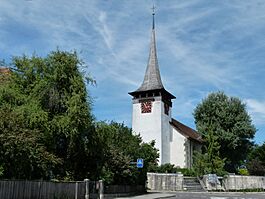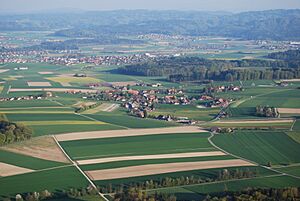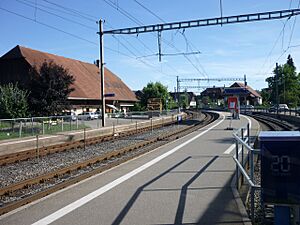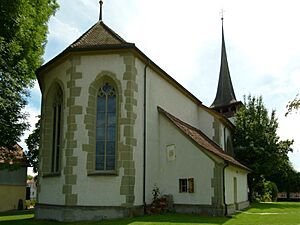Jegenstorf facts for kids
Quick facts for kids
Jegenstorf
|
||
|---|---|---|
 |
||
|
||
| Country | Switzerland | |
| Canton | Bern | |
| District | Bern-Mittelland | |
| Area | ||
| • Total | 13.49 km2 (5.21 sq mi) | |
| Elevation | 521 m (1,709 ft) | |
| Population
(Dec 2020 )
|
||
| • Total | 5,738 | |
| • Density | 425.35/km2 (1,101.7/sq mi) | |
| Postal code |
3303
|
|
| Surrounded by | Grafenried, Iffwil, Mattstetten, Münchringen, Urtenen-Schönbühl, Zauggenried, Zuzwil | |
Jegenstorf is a town, also called a municipality, in the Bern-Mittelland area in the canton of Bern in Switzerland. It's like a small county or district.
Jegenstorf has grown over the years by joining with other nearby towns. On January 1, 2010, the town of Ballmoos became part of Jegenstorf. Then, on January 1, 2014, Münchringen and Scheunen also joined Jegenstorf.
Contents
Jegenstorf's History
Jegenstorf was first mentioned in old writings in 1131 as Igistorf. Later, in 1255, it was called Jegistorf.
Early Settlements
The very first signs of people living here are ancient Hallstatt burial mounds. These are like old graves shaped like hills. They were found near the border with Münchringen. Inside these mounds, archaeologists found many cool things like arrowheads, pottery, and even gold items!
Near the village church, people also found remains of a Gallo-Roman farm. This included parts of walls, pillars, bricks, and pottery. This shows that people lived here a very long time ago.
Medieval Times and Castles
During the Middle Ages, a family called Jegenstorf owned the village. They were knights who served a powerful lord. In the 12th century, the Jegenstorf family built a moated castle (a castle surrounded by water) near the village.
Later, the village became part of the land owned by the Counts of Kyburg. In 1406, the city of Bern took control of many Kyburg villages, including Jegenstorf.
Changes in Ownership
Before 1300, the Erlach family bought some land in Jegenstorf. When the Jegenstorf family died out around 1300, other noble families took over the rest of the village. The Erlach family kept gaining power. By the 15th century, they owned the castle, the whole village, and even the local courts.
The Erlach family owned the castle until 1584. After that, other families like the Bonstetten and Wattenwyl families owned it for a while. But the Erlach family got it back in 1720.
In 1758, Karl Ludwig von Erlach sold the castle and its land. However, his family still had the right to rule over the village. This continued until 1798, when France invaded Switzerland. After the invasion, the Canton of Bern took over the rule of the village.
Peasant War and Castle Rebuilding
During the Swiss peasant war of 1653, the people of Jegenstorf attacked and robbed the castle. In response, an army from Bern burned down the village.
In 1720, Albrecht Friedrich von Erlach rebuilt the castle into a beautiful Baroque country house. He removed the old defenses and added parks and gardens. After 1758, the castle became a summer home for the rich Stürler family for nearly 200 years.
In 1934, the Stürlers sold the castle. Two years later, a group dedicated to saving Jegenstorf Castle turned it into a museum. Today, it's managed by the Jegenstorf Castle Foundation.
The Village Church
The local church in Jegenstorf was first mentioned in 1180. The Jegenstorf family originally had the right to choose the priest. Later, other noble families and then a hospital took over this right.
The church building you see today was built in 1514-1515. Its beautiful stained glass windows are from the 16th and 17th centuries. In 1528, Jegenstorf became Protestant during the Protestant Reformation, just like most of the Canton of Bern. The church served a much larger area than just the town of Jegenstorf.
Modern Times
In the past, a small number of rich landowners held all the power in Jegenstorf. Most people, especially farmers and laborers, had no say in the government. This started to change in the 1800s.
For a long time, Jegenstorf was mostly a farming village. Even though it was on an old road, new railroads and highways didn't go through it. A small local railway was built in 1916, but it wasn't used much until the 1960s. At that time, many people who worked in Bern started moving to Jegenstorf, making it grow.
In 1970, a company called Interdiscount built a facility in Jegenstorf. It became the biggest employer in the town. As more people moved in, new schools and neighborhoods were built. Jegenstorf's secondary school opened in 1879. A local hospital opened in 1891, but it closed in 1999.
Münchringen's History
Münchringen was first mentioned around 1261-1263 as Munderchingen. The nearby settlement of Holzmühle was first mentioned in 1271.
The oldest signs of people living here are Hallstatt era grave mounds. In the 13th century, both Münchringen and Holzmühle were owned by the Counts of Kyburg. Later, they came under the control of Bern.
In 1944-1946, walls and canals were built to control the Urtenen river and stop floods. In 1965, a new highway was built near Münchringen. This helped the town grow, bringing in more people and businesses. Today, Münchringen is a commuter town. This means most people who live there travel to the area around Bern for work.
Scheunen's History
Scheunen was first mentioned in 1226 as Schunon.
The oldest signs of people living in Scheunen are Hallstatt era grave mounds. These old grave mounds were even used again as a cemetery in the Early Middle Ages.
The area that is now Scheunen used to be two separate villages: Oberscheunen and Jegenstorf-Scheunen. They were part of different church areas. After 1530, both villages joined the new Reformed church in Messen. The two villages shared a school district starting in 1795. However, they remained politically separate until they officially merged in 1911.
Like Jegenstorf, these villages were also part of the Kyburg lands. After the Kyburg family died out in 1406, Bern took control of the villages.
Jegenstorf's Geography
Jegenstorf covers an area of about 8.9 square kilometers (about 3.4 square miles).
- About 63.5% of the land is used for farming.
- About 23.5% is covered by forests.
- About 12.0% has buildings or roads.
- Only 1.0% is land that can't be used for anything.
Over the years, more land has been used for buildings. Since 1982, the amount of land used for farming has gone down a bit. Rivers and lakes cover about 14 hectares (about 35 acres) in the town.
Jegenstorf is located on the Rapperswil Plateau. A plateau is a flat area of land that is higher than the land around it. The town includes the main village of Jegenstorf and several newer neighborhoods like Bachtelen, Bimer, Solecht, and Risere.
Jegenstorf's Coat of Arms
The blazon (description) of Jegenstorf's municipal coat of arms is: Per pale first per chevron dancety Argent and Gules and second per angeled fess Gules and Argent. This means it's divided down the middle. One side has a zigzag pattern in silver and red, and the other side has a slanted line in red and silver.
Jegenstorf's People (Demographics)
Jegenstorf has a population of about 5,638 people.
- As of 2014, about 10% of the people living in Jegenstorf are foreign nationals (people from other countries).
- Between 2010 and 2014, the population grew by about 6.25%.
- In 2014, for every 1,000 people, 10.5 babies were born, and 6.8 people died.
Languages Spoken
Most people in Jegenstorf (about 93.5%) speak German as their main language.
- French is the second most common language (1.1%).
- Albanian is the third (1.1%).
- There are also 38 people who speak Italian.
Age Groups
As of 2014:
- Children and teenagers (0–19 years old) make up 20.7% of the population.
- Adults (20–64 years old) are 56.3% of the population.
- Seniors (over 64 years old) make up 22.9%.
In 2015, there were about 2,191 single people, 2,733 married people, 274 widows or widowers, and 411 divorced people living in Jegenstorf.
Homes and Buildings
In 2014, there were 2,511 private homes in Jegenstorf. On average, each home had 2.23 people living in it.
- In 2015, about 63.4% of all buildings were single-family homes.
- About 12.2% of the buildings were built before 1919, and 12.6% were built between 1991 and 2000.
Historic Population
This chart shows how the population of Jegenstorf and the towns that merged into it (Ballmoos, Münchringen, and Scheunen) has changed over time.

Important Historic Sites
The Swiss Reformed church at Solothurnstrasse 1 and Jegenstorf Castle are very important historic places in Switzerland. They are listed as heritage sites of national significance. This means they are protected because of their historical and cultural value.
Jegenstorf's Economy
Jegenstorf is considered a town that is part of a larger city area, like a suburb of Bern. It's part of the agglomeration of Bern, which means it's connected to the main city.
Jobs in Jegenstorf
In 2016, there were 2,140 people working in Jegenstorf.
- About 98 people worked in 33 businesses in the primary economic sector. This means jobs like farming or forestry.
- About 282 people worked in 44 businesses in the secondary sector. This includes jobs in manufacturing or construction.
- The most jobs were in the tertiary sector, with 1,760 jobs in 250 businesses. This sector includes jobs in services, like shops, offices, or healthcare.
In 2014, about 8.7% of the population received social assistance, which is help from the government. In 2011, the unemployment rate (people looking for jobs but can't find them) was 1.9%.
Many people who live in Jegenstorf travel to other towns for work. In 2000, 1,091 workers came into Jegenstorf for their jobs, but 1,658 workers left Jegenstorf to work somewhere else. This means more people leave Jegenstorf for work than come into it.
Religion in Jegenstorf
Based on a survey from 2000:
- About 13.4% of the people were Roman Catholic.
- About 69.4% belonged to the Swiss Reformed Church (a type of Protestant church).
- About 1.40% were members of an Orthodox church.
- About 5.98% belonged to other Christian churches.
- About 2.05% were Islamic (Muslim).
- A small number of people were Buddhist or Hindu.
- About 7.18% of the population did not belong to any church, or were agnostic (not sure about God) or atheist (don't believe in God).
Education in Jegenstorf
In Jegenstorf, many people have a good education.
- About 42.5% of the population has finished upper secondary education (like high school).
- About 15.0% have completed even higher education, such as going to a university.
School System
The school system in the Canton of Bern works like this:
- One year of non-required Kindergarten.
- Six years of Primary school.
- Three years of required lower Secondary school. Here, students are grouped by their skills.
- After lower Secondary, students can continue their education or start an apprenticeship (learning a job while working).
During the 2010-2011 school year, 585 students went to school in Jegenstorf.
- There were 4 kindergarten classes with 82 students.
- There were 17 primary classes with 329 students.
- There were 9 lower secondary classes with 174 students.
In 2000, 106 students came to Jegenstorf schools from other towns, while 140 students from Jegenstorf went to schools outside the town.
Local Library
Jegenstorf has a municipal library called Gemeindebibliothek Jegenstorf.
- In 2008, the library had 12,366 books and other media.
- It loaned out 38,136 items that year.
- The library was open 282 days a year, for about 14 hours per week.
See also
 In Spanish: Jegenstorf para niños
In Spanish: Jegenstorf para niños
Images for kids












